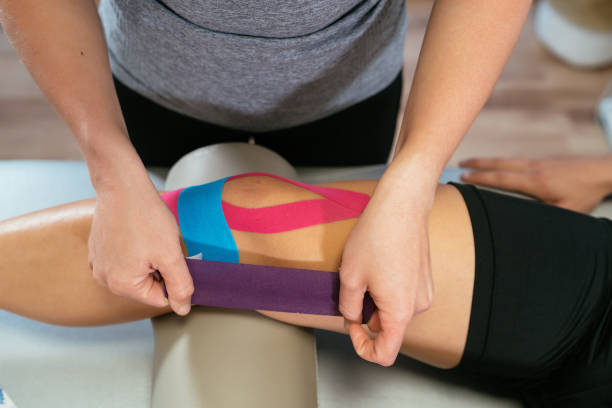Physiotherapy isn’t just about treating injuries or managing chronic health conditions. It can also help improve performance!
Having the ability to participate in the activities you love is an important part of living a healthy life. But sometimes injury or pain can put you on the sidelines. Luckily, there are ways to get back in the game!

Strengthening and Conditioning
When you’re injured, or dealing with a chronic health condition that prevents you from participating in the activities you love, it’s incredibly frustrating. Physiotherapy is a holistic approach to healing that can help patients manage their pain and return to their favorite activities or hobbies with ease.
Physiotherapy is often paired with strengthening and conditioning exercises that are specific to the patient. These exercises are designed to make muscles and joints stronger, improve control over motor functions, and prevent injury in the future. Physiotherapy also helps educate the patient in better movement techniques so that they can avoid re-injury.
While sometimes it takes a major incident to get an injury, in many cases injuries occur because of repeated poor technique. Physiotherapists in Canberra ACT are able to assess a person’s posture and stance to identify issues that could be contributing to injury and teach them improved techniques for their sport or hobby to reduce the risk of future injuries.
Continuing to participate in your favourite hobbies is important to maintain physical and mental wellbeing. Having a physiotherapist that is willing to work with you through a step-by-step process and guide you towards achieving your goals can make all the difference. It’s also important to find a therapist that will communicate well with you and keep you up-to-date on your progress.
Post-surgery Recovery
In addition to treating injury and pain, physiotherapy is useful for improving overall health. Many people who see a physiotherapist for an injury are eager to get back in the gym or playing the sport they love, but it’s important to take it slow and gradually increase your exercise and strength training over time. Physio Belconnen understand how to safely ramp up your workout routine, and they can teach you the best techniques for exercising that won’t put your body at risk of an injury or pain.
Physical movement also helps reduce inflammation, stiffness and pain. In fact, it can be so effective that it can make it less likely you’ll need painkillers to deal with your discomfort.
Depending on the type of surgery you’ve had, your doctor may recommend that you avoid strenuous exercises for several weeks following the procedure. However, light cardio exercise, such as walking the Phoenix area trails or cycling at a low setting on a stationary bike, can be beneficial and help you maintain your energy levels while you recover from surgery.
It’s always a good idea to check in with your physiotherapist before ramping up your workout routine after surgery. They can teach you the best ways to perform exercises that won’t put your body at risk and help you develop a plan for gradual increases in intensity, frequency and duration over time.

Preventing Injuries in the Future
If you’ve been injured and can’t participate in your favourite sports, workouts, or daily activities, it can be tough to maintain a positive outlook on life. Physiotherapists can help you get back to doing the things you love by teaching you techniques that will reduce your risk of injury in the future.
They are experts in the body and its movements, so they know which stretches, exercises, and routines will strengthen muscles, improve flexibility, and prevent injuries. They’ll also assess your previous workouts or sport performance to find out if your technique contributed to the injury and can teach you new strategies to ensure you don’t get hurt again.
Once you’ve healed from an injury, a physical therapist can create a treatment plan that will minimize pain without the need for surgery or drugs. They’ll identify what caused your pain and use a variety of tools to address it, such as strengthening exercises, mobility work, hands-on manual therapy, customized bracing, and kinesiology taping.
Injuries happen, no matter how careful you are. But getting back to your regular routine shouldn’t have to be a slow process. With the right physiotherapy program, you can recover faster and reach your health goals before too long. Your therapist will work with you to set realistic recovery goals and create a schedule that fits your lifestyle.
Pain Management
If you suffer from a painful injury, physiotherapy is an effective and natural way to reduce pain in your body. This treatment helps you overcome the fear of starting an exercise program and gradually build your strength and flexibility to manage the pain over time. It is also important to understand that the root cause of the pain should be treated, not just the symptoms.
Physiotherapists use various techniques to improve the overall condition of your body and alleviate pain, such as joint or soft tissue mobilization. They can also prescribe exercises that will improve your balance, stability and movement. This will help to relieve your pain and reduce the frequency of onsets in the future.
They will ask you to fill out questionnaires and perform tests and movements to understand how your pain affects your daily life. They will then use this information to develop a bespoke exercise plan to boost your quality of life. This will include stretching and strengthening exercises, as well as aerobic exercises to get your heart rate up without placing too much strain on your joints.
They will also use a variety of pain management techniques, such as TENS (which uses low-voltage electrical stimulation to stimulate muscle fibers and block pain signals from reaching the brain), ultrasound therapy and massage. They may also recommend other treatments like osteopathy, acupuncture or kinesiology.
